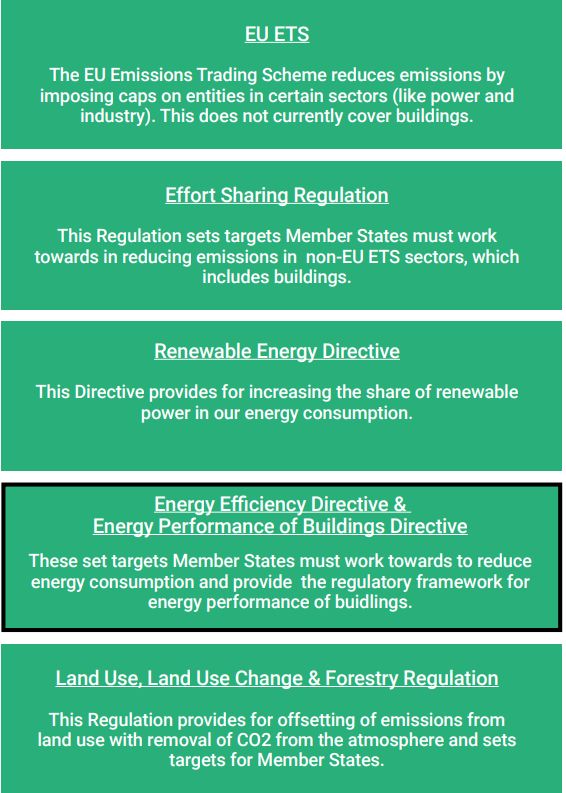CONSTRUCTION is no different, and significant law and policy reform to decarbonise the built environment is underway. What is coming down the track?
BLUEPRINTS
A concluding statement at COP 26, "COP 27 starts now", encapsulates the rapid pace of reform as climate action takes on increased urgency. For Irish business, the EU's Fit for 55 package provides information on what to expect this decade. A main output so far of the 'European Green Deal', Fit for 55 comprises legislative proposals detailing how the EU intends to reduce greenhouse gas emissions by 2030 by 55% compared to 1990 levels, in order to be carbon neutral by 2050.
In Ireland, the Climate Action and Low Carbon Development Acts 2015 to 2021 require annual updates to the Climate Action Plan, 15 year carbon budget programmes and sectoral emission ceilings, and regular national adaptation frameworks and sectoral adaptation plans. The €125bn Climate Action Plan 2021 and €165 National Development Plan 2021-2030 also give indications of Government plans for meeting Ireland's climate targets.
HUGE ENERGY CONSUMPTION
To date, the greatest decline in emissions has been in sectors covered by the EU Emissions Trading System, particularly power plants. Continued decarbonisation of energy will be critical. However there is now going to be a much more intense focus on decarbonising buildings and transport, without which climate targets will not be met.
"Those aware of what is coming down the track will be best placed to seize the opportunities presented by the considerable task ahead."
The Fit for 55 proposal for a revised Energy Efficiency Directive states: "Heating and cooling consumes half of Union FEC [final energy consumption], making it the biggest energy end-use sector. .... Heating and cooling, therefore, plays a crucial role in the Union's ambition to transition into a clean and carbon-neutral economy by 2050. Much of the effort is needed in the field of better insulating buildings, but there is also potential in terms of more efficiently supplying the heat or cold needed. ... Buildings are responsible for about 40% of the Union's total energy consumption ...
Similarly, Ireland's Climate Action Plan 2021 states: "Irish homes use 7% more energy than the EU average, and emit almost 60% more CO2 than the average EU home. Currently, our buildings are 70% reliant on fossil fuels, and over 80% of our homes and other buildings assessed for their BER have a rating of C or worse."
There is clearly much to be done in terms of retrofitting and new builds, in order to increase energy efficiency (for example with better insulation and other building fabric improvements); to install heating systems which are not reliant on fossil fuels (such as electric pumps); to increase the share of renewable energy powering our heating systems; and to harness both waste heat and renewables in district heating.
EU LEGAL FRAMEWORK: WHERE DOES BUILT ENVIRONMENT COME IN?
Key components of the EU's framework for driving down emissions are shown briefly below. The instruments in the box outlined in black are particularly relevant to the built environment but others are also relevant.

FIT FOR 55: WHAT CHANGES WILL IMPACT THE BUILT ENVIRONMENT?
Fit for 55 proposes to amend much of the above law by changing what needs to happen by 2030, if carbon neutrality by 2050 is to be a reality. We have identified some key themes we think it will be helpful for the construction sector to know.
First, many targets will be raised, with the measures required to reach them strengthened.
- The proposal to revise the Energy Efficiency Directive would mean that primary energy consumption (which is total energy demand, including the energy sector and transmission losses) would have to decrease by 39% by 2030 compared to 2005. Final energy consumption (which is what end users actually consume) would have to decrease by 36% by 2030 compared to 2005. Currently, both targets are 32.5%. Member States would continue to describe what they intend to do in their National Energy and Climate Plans, but the Commission could in some circumstances require further action.
"All public bodies would be required to reduce their final energy consumption by 1.7% per year. Another target would require at least 3% of the floor space of all buildings owned by public bodies to be renovated each year to nZEB standards."
Member States would have to ensure that the 'energy efficiency first' principle is taken into account in planning, policy and major investment decisions related to energy systems and non-energy sectors with an impact on energy consumption – a key example here is social housing.
All public bodies would be required to reduce their final energy consumption by 1.7% per year. Another target would require at least 3% of the floor space of all buildings owned by public bodies to be renovated each year to nZEB standards. Public procurement processes would have to apply the energy efficiency first principle and procure only high energy-efficiency performance building and works. As in other areas of change, innovations supported by the public sector can be a real driver of change, although energy efficiency in commercial buildings has evolved significantly over the last decade and can add real value to newly developed assets.
Member States would have to achieve cumulative end-use energy savings per year of at least 1.8% in the period 2021-2023 (nearly double the current requirement) and 1.5% in the period 2024-2030 through an energy efficiency obligation scheme or alternative policy measures like taxation. Minimum requirements for efficient district heating and cooling systems would be introduced and gradually increased with a view to ensuring fully decarbonised heat / cooling supply in efficient district heating or cooling systems by 2050.
Companies using certain levels of energy would have to implement an energy management system and undertake energy audits. This differs from the current situation in which the requirement is for Member States to ensure that enterprises that are not SMEs undertake energy audits.
" Currently, the Effort Sharing Regulation binds Member States to reduce emissions in several sectors (including buildings) by 30% by 2030 as against 2005 levels, and it is proposed to increase this to 40%. National targets would change in 2023 with Ireland's set to increase significantly, from 30% to 42%.
" Publication of a proposal to revise the Energy Performance of Buildings Directive is imminent. It is expected to identify measures to at least double the rate of renovations in line with the Renovation Wave Strategy. This Directive provides for new buildings to be nearly zero-energy, minimum energy performance requirements, energy performance certificates, and requirements for electric vehicle ("EV") charging infrastructure associated with buildings – so the new proposal should be interesting!
Second, there will be more mechanisms relevant to the built environment.
" It is proposed to introduce a new emissions trading scheme for upstream suppliers of fuel to buildings and road transport from 2026. This would mean that pressure to reduce emissions from buildings would come from both a new cap and trade scheme for private entities, as well as targets imposed on Ireland by the Effort Sharing Regulation. 25% of revenues from this new scheme would fund a Social Climate Fund (running to tens of billions of euro) to support building improvements and people at risk of energy poverty.
" The proposal to amend the Renewable Energy Directive includes a new indicative EU target to use renewables for 49% of energy in buildings by 2030. The proposal seeks to strengthen provisions on mainstreaming renewable energy in heating and cooling, requiring Member States to increase the share of renewable energy in heating and cooling by at least 1.1% each year. (Each Member State would 'endeavour' to achieve an additional amount, in Ireland's case 2.9%.) A separate target aims to double the rate of increase of renewable or waste heat in district heating.
" A proposed recast Energy Taxation Directive aims to align taxation of energy products and electricity to EU climate and environmental objectives.
Third, buildings will be part of energy system integration and digitalisation.
The EU Strategy for Energy System Integration focuses on (i) energy efficiency (including reuse of waste heat in district heating), (ii) greater electrification (including through heat pumps and EVs), and (iii) where electrification is difficult, use of clean fuels like hydrogen. The Renewable Energy Directive aims to remove barriers to the electrification of heating, including by addressing a shortage of installers of renewable heating systems, providing more flexibility around allowable renewable heating technologies, updating the list of renewable energy sources that district heating and cooling networks should accommodate, and requiring integration of thermal energy storage. Member States would have to ensure smart charging capability for EVs, as batteries in vehicles parked at our homes become potential sources of energy to be fed to the grid. Delivering more renewable generation capacity in Ireland is going to be really important.
TRACKING DEVELOPMENTS - UNDERSTANDING OPPORTUNITIES
The increased emissions reduction targets at EU and domestic level are really significant. The scale of change needed to achieve them is immense and a decade is short. Many of the actions required will be challenging and emissions reduction will progressively become more difficult to achieve. Buildings have been identified as a huge emitter of greenhouse gases and some of the measures to address that are comparatively easy. Fit for 55 is undergoing the legislative process in Brussels and is an EU priority. Those aware of what is coming down the track will be best placed to seize the opportunities presented by the considerable task ahead.
This article contains a general summary of developments and is not a complete or definitive statement of the law. Specific legal advice should be obtained where appropriate.


